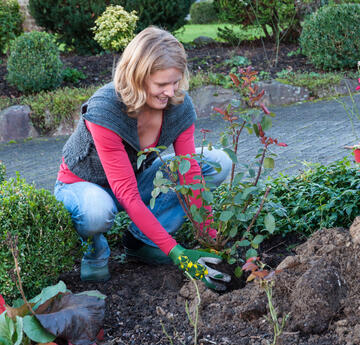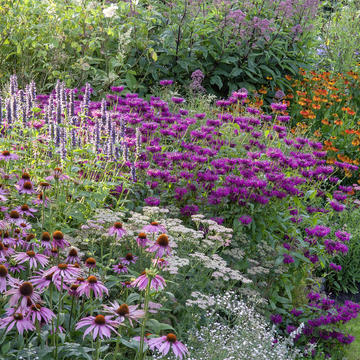Planting Hydrangeas: Tips for flower beds and pots
Want to plant new Hydrangeas? Here are the most important planting tips – for flower beds and pots.

When planting Hydrangeas, you should consider their specific requirements in terms of location and soil
A few things can go wrong when planting Hydrangeas, the popular flowering shrubs have particular preferences in terms of soil and location. Whether it’s in flower beds or pots: We explain what you need to do to be rewarded with abundant blooms.
- The best time to plant is mid-March to mid-August.
- Hydrangeas need a partially shaded location.
- The soil should be rich in humus, loose, slightly acidic and low in lime.
- The diameter of the planting hole should be twice as big as the root ball.
- Don’t plant Hydrangeas too deeply: The top of the root ball and the soil should be on the same level.
- Water Hydrangeas thoroughly and give them plenty of water after planting.
There are now many varieties and Hybrids of the Bigleaf Hydrangea (Hydrangea macrophylla). But not all of them are recommended and easy to care for. You can make many mistakes when it comes to pruning Hydrangeas in spring: If you buy old varieties, you may only remove the shoot tips with the previous year's inflorescences - too much pruning will result in the flowering being completely or at least significantly weaker for one year.
The ideal time for planting all hydrangeas is spring. It is best to wait until early March, so that the freshly planted hydrangeas are not immediately affected by a more severe late frost. For the Bigleaf and Mountain Hydrangeas, in cold regions it is even better to wait until after the Ice Saints in mid-May. In any case, if you plant earlier, you should have a winter fleece ready so that you can cover the flowering shrubs if another frosty night threatens.
In principle, you can plant Hydrangeas with potted root balls even later - even well into the summer, as long as you provide the shrubs with good water afterwards. Autumn, however, is a rather unfavorable time for planting: especially the shoots of cottage hydrangeas and plate hydrangeas usually do not mature properly in autumn and then freeze back to a greater or lesser extent during the winter months. Well-established hydrangeas are less affected by this, but freshly planted shrubs can be more severely damaged. Fall is less critical as a planting time for Smooth Hydrangeas and Panicle Hydrangeas. They are cut back heavily in the spring anyway, as they do not form their flower buds until the new branches are in bud. On the other hand, the flowering plants of all other species - including the rarer ones such as Oakleaf hydrangea, Climbing Hydrangea and Velvet Hydrangea - are already formed in the buds during the preseason. That is why after harsher winters, their flowering may fail completely if you choose autumn as the time of planting.

Irrespective of the variety you choose, when buying Hydrangeas, you should make sure that the crown is well branched and the shoots are free from damage and pests. Take a quick look at the root ball by taking the plants out of the pot: The roots should have penetrated the soil well, but should not be too dense. If long, white roots have formed along the bottom edge of the pot, this is a sign that the Hydrangea has been in the pot for too long. You’re best to either avoid plants with roots like this or to use garden shears to remove the uncontrolled growth from the root ball before planting.

When choosing a location, it makes sense to consider the origin of the shrub. Found on the edges of forests, Hydrangeas thrive in conditions similar to their natural habitat. Plant Hydrangeas in partial shade or very light shade. On the edges of forests, treetops provide the shrubs with intermittent shade, protecting them from too much light and, above all, from the blazing midday sun. Flower beds under large shrubs or trees with umbrella-like crowns are therefore a particularly good place to plant Hydrangeas in the garden. Scots Pines or Flowering Dogwoods are perfect companions for the shrubs, as they have tolerant roots, which will not compete with the roots of Hydrangeas. Flower beds in front of west facing house wall or garden walls are also very suitable.
Make sure that the Hydrangeas are not too exposed. Some species, such as Bigleaf and Mountain Hydrangeas, are somewhat susceptible to frost and should be sheltered from the wind, especially in winter, as freezing easterly winds can cause damage. This often destroys the flowering of older varieties that do not rebloom.
Before planting Hydrangeas, you need to prepare the soil. In flower beds, the soil should be loose, moist and slightly acidic. The recommended pH value for Hydrangeas is between five and six. You can buy test strips, among other things, in specialist stores, making it very easy to find out the pH value. For rich flowering, the soil should have a high humus content.

Like many forest plants, Hydrangeas have shallow root systems – this means that their roots do not grow deep, but rather broadly, they remain close to the ground surface. You should therefore dig a very wide planting hole in the flower bed. The diameter should be about twice as wide as the root ball of the Hydrangea. Keep Hydrangeas a sufficient distance from other plants – especially those with shallow root systems – so that the roots do not get in each other’s way. It’s best to mix the dug clay soil with equal parts of leaf humus and bark humus before refilling the hole. You should also use the spade to loosen the bottom of the planting hole to improve drainage. Putting some coarse sand under the roots can optimize the drainage of compacted subsoils.
For sandy garden soils, it is sufficient to mix leaf humus or composted cow dung under the excavation. Do not rely on conventional garden compost for soil improvement. It generally contains too much salt and lime.
Hydrangeas should always be planted so that the root ball is at ground level. Put the soil back in the hole and carefully tread down with the front of your shoe sole to compact it. Lastly, water the Hydrangea thoroughly.
Hydrangeas should not dry out after planting. They need plenty of water on a regular basis in the early days. Only use water with a low lime content or rainwater. Hydrangeas are not as sensitive as Rhododendrons, they tolerate lime, but only in small quantities. Using leaves or bark humus as a mulch layer helps to retain moisture in the soil and minimizes evaporation. If you are using bark humus, you should first distribute a few handfuls of horn shavings around the root area to prevent a nitrogen deficiency in the soil.

Planting Hydrangeas in a pot hydrangeas in pots is similar to planting them in flower beds. Bigleaf and Mountain Hydrangea varieties with compact growth habits are a good choice for pots. You should choose a wind-sheltered and partially shaded spot on the balcony or patio. Since Hydrangeas are shallow-rooted, a rather flat planter with a large diameter is optimal - the root system can develop well in it. At least 10 liters of soil are recommended for plants that are 9.84 to 11.81 inches tall.

Plant potted Hydrangeas in Rhododendron or Azalea soil from specialist stores – it meets the needs of the flowering shrubs. At specialist stores, you can now even buy special potting soils for "Endless Summer" Hydrangeas, which of course are also suitable for other Bigleaf and Mountain Hydrangeas. Putting a shard of clay over the drainage hole prevents the substrate from being washed out of the pot during watering. Insert the root ball so that the surface is 1.18 inches below the rim of the pot. This distance ensures that water doesn’t overflow. Pour in enough soil so that it is level with the root ball after gently pressing down. Finally, water the plant thoroughly and put the pot in a partially shaded spot, which is protected from the blazing midday sun. The flowering shrubs should generally be kept moist, not only after planting. Potted Hydrangeas need to be watered more frequently than those in the garden, as the soil in the pot dries out faster. You should also feed the plants regularly with Hydrangea fertilizer. It’s best to use a liquid fertilizer, adding it to the water according to the dosage information on the packet.




